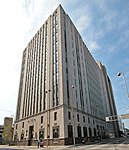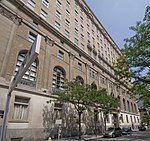Equestrian statue of William Henry Harrison
1896 establishments in Ohio1896 sculpturesBronze sculptures in OhioEquestrian statues in the United StatesMonuments and memorials in Ohio ... and 9 more
Outdoor sculptures in CincinnatiRelocated buildings and structures in OhioSculptures of men in OhioStatues in CincinnatiStatues of presidents of the United StatesUse American English from February 2021Use mdy dates from February 2021William Henry HarrisonWorld's Columbian Exposition

An equestrian statue of William Henry Harrison stands in Cincinnati's Piatt Park, in the United States. The monumental statue was designed by sculptor Louis Rebisso and was unveiled on Decoration Day, 1896. The statue has been the subject of recent controversy due to Harrison being a slaveowner, with efforts made to remove the statue during the George Floyd protests.
Excerpt from the Wikipedia article Equestrian statue of William Henry Harrison (License: CC BY-SA 3.0, Authors, Images).Equestrian statue of William Henry Harrison
West Garfield Place, Cincinnati West End
Geographical coordinates (GPS) Address External links Nearby Places Show on map
Geographical coordinates (GPS)
| Latitude | Longitude |
|---|---|
| N 39.104069444444 ° | E -84.516827777778 ° |
Address
William Henry Harrison
West Garfield Place
45202 Cincinnati, West End
Ohio, United States
Open on Google Maps










